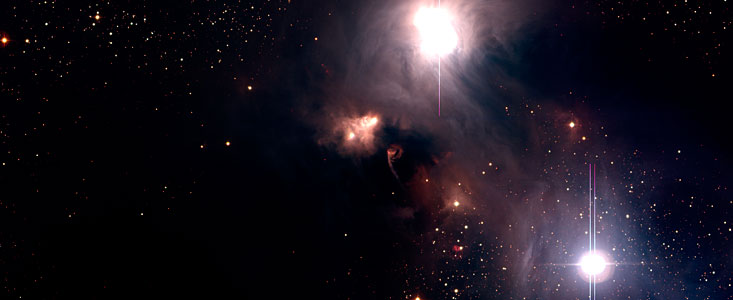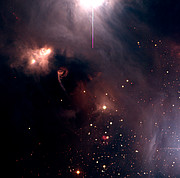Nota de prensa
Stars and Nebulae in the Southern Crown
A Colourful WFI Portrait of a Star-Forming Region
6 de Octubre de 2000
The R Coronae Australis complex of young stars and interstellar gas clouds is one of the nearest star-forming regions, at a distance of approx. 500 light-years from the Sun. It is seen in the southern constellation of that name (The "Southern Crown"). Images of this sky area were recently obtained with the Wide Field Imager (WFI), a 67-million pixel digital camera that is installed at the 2.2-metre MPG/ESO Telescope at ESO's La Silla Observatory.
Some of these exposures have been combined into a magnificent colour image, here reproduced as ESO Press Photo eso0031a. The field shown measures about 4.7 x 4.7 light-years. It displays the central part of the complex, its brightest stars, and the nebulosity that they illuminate. The interstellar clouds that are associated with the complex are visible all across this field and also beyond its borders (on other exposures), due to the obscuring effect of the dust particles that "dim" the light of stars behind these clouds. This effect is particularly noticeable in the lower left corner where very few stars are seen.
R Coronae Australis, the bright star from which the entire complex is named, is located at the center of the field and illuminates the reddish nebula around it. The bright star in the lower part, illuminating a somewhat bluer nebula, is known as TY Coronae Australis .
The brightness of these two stars and several others in the same field is variable. They belong to the so-called "T Tauri" class, a type that is quite common in star-forming regions. T Tauri stars are in the early stages of stellar evolution and display various observable characteristics of this phase, e.g. emission at visible and infrared wavelengths due to the accretion of matter left over from their formation, as well as X-ray emission.
The nebulosity seen in this picture is mostly due to reflection of the stellar light by small dust particles. The stars in the R Coronae Australis complex do not emit sufficient ultraviolet light to ionize a substantial fraction of the surrounding hydrogen, and thereby cause this gas to glow.
However, some smaller features are also visible (one is seen in the upper left corner of ESO Press Photo eso0031b) which emit light by a different mechanism. These are so-called Herbig-Haro objects, i.e., dense clumps of gas ejected from the immediate vicinity of newly formed stars with velocities of about 200 km/sec. When such clumps ram into the gas, the atoms are heated (excited) and start to shine. See also ESO Press Photo eso9948 of the object HH-34 in Orion.
Other WFI images are available at the WFI Photo Gallery.
Acerca de la nota de prensa
| Nota de prensa No.: | eso0031 |
| Legacy ID: | Photo 25a-b/00 |
| Nombre: | R Coronae Australis |
| Tipo: | Milky Way : Star : Type : Variable Milky Way : Nebula : Type : Star Formation |
| Facility: | MPG/ESO 2.2-metre telescope |
| Instruments: | WFI |
Our use of Cookies
We use cookies that are essential for accessing our websites and using our services. We also use cookies to analyse, measure and improve our websites’ performance, to enable content sharing via social media and to display media content hosted on third-party platforms.
ESO Cookies Policy
The European Organisation for Astronomical Research in the Southern Hemisphere (ESO) is the pre-eminent intergovernmental science and technology organisation in astronomy. It carries out an ambitious programme focused on the design, construction and operation of powerful ground-based observing facilities for astronomy.
This Cookies Policy is intended to provide clarity by outlining the cookies used on the ESO public websites, their functions, the options you have for controlling them, and the ways you can contact us for additional details.
What are cookies?
Cookies are small pieces of data stored on your device by websites you visit. They serve various purposes, such as remembering login credentials and preferences and enhance your browsing experience.
Categories of cookies we use
Essential cookies (always active): These cookies are strictly necessary for the proper functioning of our website. Without these cookies, the website cannot operate correctly, and certain services, such as logging in or accessing secure areas, may not be available; because they are essential for the website’s operation, they cannot be disabled.
Functional Cookies: These cookies enhance your browsing experience by enabling additional features and personalization, such as remembering your preferences and settings. While not strictly necessary for the website to function, they improve usability and convenience; these cookies are only placed if you provide your consent.
Analytics cookies: These cookies collect information about how visitors interact with our website, such as which pages are visited most often and how users navigate the site. This data helps us improve website performance, optimize content, and enhance the user experience; these cookies are only placed if you provide your consent. We use the following analytics cookies.
Matomo Cookies:
This website uses Matomo (formerly Piwik), an open source software which enables the statistical analysis of website visits. Matomo uses cookies (text files) which are saved on your computer and which allow us to analyze how you use our website. The website user information generated by the cookies will only be saved on the servers of our IT Department. We use this information to analyze www.eso.org visits and to prepare reports on website activities. These data will not be disclosed to third parties.
On behalf of ESO, Matomo will use this information for the purpose of evaluating your use of the website, compiling reports on website activity and providing other services relating to website activity and internet usage.
Matomo cookies settings:
Additional Third-party cookies on ESO websites: some of our pages display content from external providers, e.g. YouTube.
Such third-party services are outside of ESO control and may, at any time, change their terms of service, use of cookies, etc.
YouTube: Some videos on the ESO website are embedded from ESO’s official YouTube channel. We have enabled YouTube’s privacy-enhanced mode, meaning that no cookies are set unless the user actively clicks on the video to play it. Additionally, in this mode, YouTube does not store any personally identifiable cookie data for embedded video playbacks. For more details, please refer to YouTube’s embedding videos information page.
Cookies can also be classified based on the following elements.
Regarding the domain, there are:
- First-party cookies, set by the website you are currently visiting. They are stored by the same domain that you are browsing and are used to enhance your experience on that site;
- Third-party cookies, set by a domain other than the one you are currently visiting.
As for their duration, cookies can be:
- Browser-session cookies, which are deleted when the user closes the browser;
- Stored cookies, which stay on the user's device for a predetermined period of time.
How to manage cookies
Cookie settings: You can modify your cookie choices for the ESO webpages at any time by clicking on the link Cookie settings at the bottom of any page.
In your browser: If you wish to delete cookies or instruct your browser to delete or block cookies by default, please visit the help pages of your browser:
Please be aware that if you delete or decline cookies, certain functionalities of our website may be not be available and your browsing experience may be affected.
You can set most browsers to prevent any cookies being placed on your device, but you may then have to manually adjust some preferences every time you visit a site/page. And some services and functionalities may not work properly at all (e.g. profile logging-in, shop check out).
Updates to the ESO Cookies Policy
The ESO Cookies Policy may be subject to future updates, which will be made available on this page.
Additional information
For any queries related to cookies, please contact: pdprATesoDOTorg.
As ESO public webpages are managed by our Department of Communication, your questions will be dealt with the support of the said Department.


